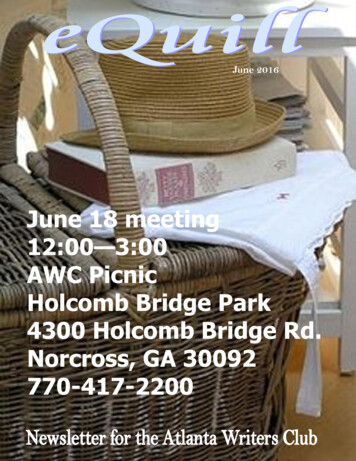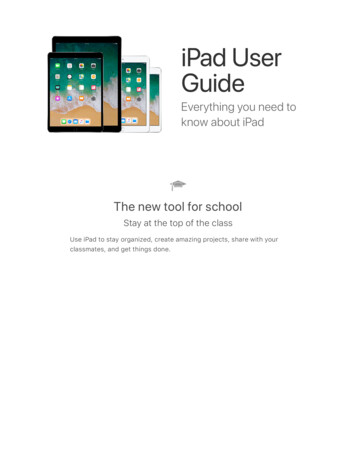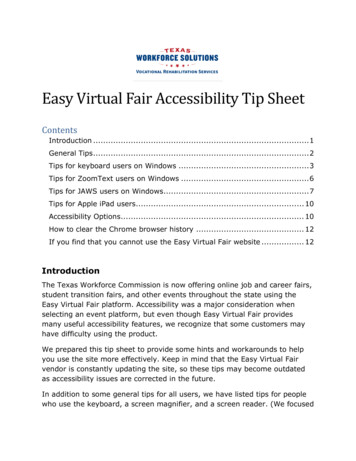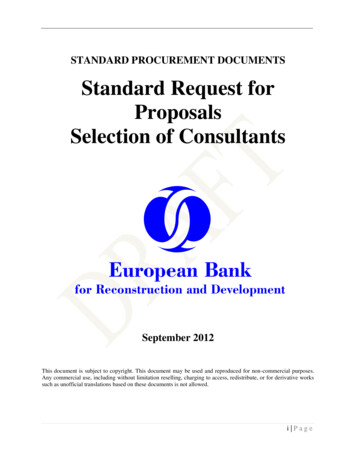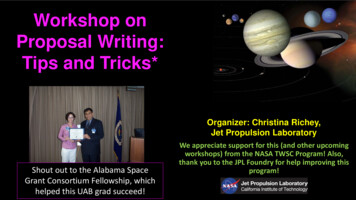
Transcription
Workshop onProposal Writing:Tips and Tricks*Organizer: Christina Richey,Jet Propulsion LaboratoryShout out to the Alabama SpaceGrant Consortium Fellowship, whichhelped this UAB grad succeed!We appreciate support for this (and other upcomingworkshops) from the NASA TWSC Program! Also,thank you to the JPL Foundry for help improving thisprogram!
Agenda1:00 PM: logistics and welcome1:10: Proposal Lifecyle1:25: ROSES, NSPIRES, and SARA1:40: Proposal Writing Guidance & Activity 12:15: Story #12:30: BREAK2:40: Peer Review3:15: Story #23:30: Activity 2: Dissecting a Panel Review3:45: Activity 3: Red Team of proposal4:10: Story #3Tip #1: Take a FULL ProposalWriting Workshop at a laterdate!For NASA ROSES ones providedby me (via HQ): AGU, AAS, LPSCVirtual Workshops will start thisFall!4:25: Selections and Programmatic Balance4:35: Activity #4: Values Exercise4:50: Wrap up & Feedback1
The Process ishDefine your researchtopicWrite, Critique,WriteRead Guidebook&ScienceProgram CallThink through yourproposalPickprogramRefine yourresearch topicAssignedSubmit ProposalPeer Review ofProposalsCompetedSelection ofProposals2
A quick intro: SMD, ROSES, and SARA
What does the NASA Science Pot of Money Look Like? NASA is the premier funding agency for Earth andSpace Science research– 600M annual R&A budget with 50 R&A programs– Each program has anywherefrom 1M- 15MScienceavailable each year NASA’s science research programs are managed bythe Science Mission Directorate (SMD, led by theAA), which has 4 science divisions (led by the DDs)– Earth Science, Heliophysics, Astrophysics, andPlanetary ScienceAssignedCompeted4
ROSES: Research Opportunities in Earth and Space ScienceAll NASA SMD R&A funding is offered through the Research Opportunities inSpace and Earth Science (ROSES) NRA*ROSES is divided into two parts:1. Summary of Solicitation (SoS): describes the overall opportunity and givesproposal and submission information2. Appendices: one per division plus cross-division listing all programsEach Appendix also has an Overview Section!A. Earth ScienceB. HeliophysicsC. Planetary ScienceD. AstrophysicsE. Cross-Divisional ProgramsReleased Mid-February every year (ROSES19 released on 3/14/19), andupdates are reported constantly!5
SARA: The Service and Advice for Research and Analysis siteThis site is specifically for Research & Analysis in SMD at NASA! How to guideFAQs (including big changes made yearly)NSPIRES Helpful HintsGrant StatisticsContact information for Program OfficersWays to review or to recommend reviewersIncludes contact information for the R&A Lead for SMD, Max Bernstein:sara@nasa.gov.https://sara.nasa.gov or https://science.nasa.gov/researchers6
The SARA site: https://sara.nasa.gov7
Proposal Writing Guidance
Managing ExpectationsWhat will not happen:What will happen: You will not write a great piece ofScienceliterature You will not definitively answer thegrand question plaguing thecommunity Your audience will not review yourproposal in a quiet, uninterruptedsetting Your audience will not be worldexperts on your topic Your audience will not accept yourapproach without question You will write a focused, no frillsdocument You will answer a focused, wellposed question of limited scope Your audience will quickly reviewyour proposal amid the chaos of theirown life Your audience will be colleaguesfrom similar fieldsAssignedCompeted Your audience will be skeptical andcritical9
Know Your Vision Have a vision of work you would like to do– Target your work/proposal to the appropriate call—be responsive– Don’t find a call and figure out what to propose—just to get fundingProposal writing is a long-term processScience– Your reputation is made by how well you deliver on every proposal you write and win (orlose)Proposal writing involves more than writing– Serve on committees (be a reviewer!)– Chair special sessions at meetings– Publish papersAssignedCompeted– Work with program managers– Participate in and/or convene relevant workshops (and then follow up with a report thatcan be cited)10
Know Your Work’s Place in the Grander Scheme Read the Call for Proposals carefullyScience Understand the programmaticrelevance of your idea– What NASA missions will the proposed work make cheaper, better, orpossible at all?– Use National Academy reports, conference reviews, NASA Strategic Plans,Roadmaps for guidance Ask colleagues, supervisor, etc. for helpAssignedCompeted11
Organize Your Work! Organization is key! Provide clear signposts throughout the proposalScienceAssignedCompeted Use the SARA website: https://science.nasa.gov/researchers/sara/faqs/12
Generic Outline vs Official Compliance Outline1. Title2. Abstract3. Introduction4. Problem Statement and Objectives5. Science Background and Rationale6. Technical Approach7. Expected Outcome/Benefits8. Education and Public Outreach9. Management Plan10.Cost Plan11.Personnel12.Facilities13.Appendices NASA ROSES Table 1 (For SMD) Use this as a checklist for ensuring you have allcompliant materials needed to submit your ROSESScience2018 proposal. Need a hard copy? Check the ROSES Summary ofSolicitation (SoS) each year ydocument/cmdocumentid 611943/solicitAssignedCompetedationId citationDocument 1/ROSES2018SoSlinksFixed100418.pdf13
Abstract Will be the first thing read May be the only thing read (particularly by the final selector) Should succinctly frame and distill the proposal ScienceState the problemSummarize the solutionSummarize the benefitsShow how the work relates to the callGive the time frameMention the team and qualifications Write it expansively, then cut it down Remember Step-1 - Step-2 editsAssignedCompeted14
Introduction Shape it as an extended abstract, a guide and roadmap to the rest of theproposal Emphasize clarity, readability, absence of jargonScience Demonstrate your grasp of the field Offer a short, well-researched overview of relevant science and technology, aswell as current practice state of the art Cite key references Include 1 2 figures showing state of the art and how you will advance itAssignedCompeted When reviewer is arguing on your behalf, they can jump to a compelling figure15
Problem Statement and ObjectiveClearly define the problem and continuously reference back to it,and box this in!ScienceEvery proposed action should betraceable to the stated objective!AssignedCompeted16
General Guidance Thoroughly review and cite the relevant literature Avoid full pages of text Accentuate the positive– Avoid creating the rabbit holefor reviewers to fallSciencedown Be clear and explicit. Highlight your strengths and explain how you intendto mitigate your weaknesses Define acronyms and unfamiliar technical terms onfirst use RUN SPELL-CEHCKCaptionsareCompetedread before detailedAssignedtext. Use graphics and figureseffectively for impact.– Proof-read to avoid irritating your reviewer17
Visualizing Success Use figures, tables, diagrams, and other visual aids to help shape your proposal and guide thereader.ScienceImages courtesy of Hannah Jang-Condell (University of Wyoming)18
Fonts Mater Here’s a paragraph of random, useless words. The words are not the point, thepoint is readability. And not just easier for you to read, but easiest for yourreviewers to read. The more complicated your paragraph, the more you request thereviewer’s brain to process the words before they process the content and meaningbehind those words. Do yourself a favor, and make the content, and the meaning,Scienceeasier to get to. Here’s a paragraph of random, useless words. The words are not the point, thepoint is readability. And not just easier for you to read, but easiest for yourreviewers to read. The more complicated your paragraph, the more you request theAssignedCompeted and meaningreviewer’s brain to process the words before they processthe contentbehind those words. Do yourself a favor, and make the content, and the meaning,easier to get to.19
Fonts Mater (Continued) Know thy audience: 10% of the world population and 15% of STEM populations havedyslexia. Mono spaced (Courier) and sans serif fonts (Verdana, Arial, Calibri) areeasiest to read, whereas serif fonts (Times New Roman) and fancy fonts (whatever this is) arethe hardest. Italic serif fonts (like this one in Time New Roman) are all but impossible. ScienceUse Sans Serif fonts whenever possible!If you MUST switch to italics, switch to sans serif fonts italics (like Calibri).Use a different font for your captions of figures and box the figure in.Also bold an entire sentence. And if you need to highlight two things in one paragraph,use colors to your advantage (next slide)AssignedCompeted For more iles/good fonts for dyslexia study.pdf20
Colors Mater Know thy audience: Folks may be colorblind as well, and many of us print documents gray-scaled on blackand white printers. Have you made your figures such that they still can be seen in gray scale?ScienceAssigned CompetedFor more info: tinct-colors/21
Overall Proposal Development Advice Read the Call: Are you responsive? Demonstrate excellence; don’t claim it You need a reviewer to champion your proposal– Make it easier for them by providingScience concise material up front Read the Call again Examine the selection criteria and directly address them up front– A reviewer should be able to lift sentences from your introduction that could go into theirreview Go back and really read the Call Proposals lose because of single sentences or paragraphsAssignedCompeted– 00-words-to-avoid-in-proposals/– Get folks to review your work before submitting and use their feedback22
Proposal Writing: MistakesWays you can avoid making common proposal mistakes*-Make sure you have someone edit your work-Have others review your work, scientificallyScience-Start as a co-I or student member and learn fromothers!These are twodifferent people,with differentagendas!-Serve on panels for experienceAssignedCompeted-NASA ROSES: ew-panels/ Please respond as soon as possible If you can’t travel, let us know that you would be willing to be a virtual panelist Offer to serve as an external if needed23
Peer Review
The BasicsEvery Proposal has two Audiences1. Program Officer, Manager, Point of ContactScience the Program’s Ensures that the work will furtherobjectives and verifying that funds/time/etc. willbe used properly Relies on you writing a COMPLIANT proposal2. Review Panel Ensures that the work is of high scientific qualityAssignedCompetedYour job is to make it as easy as possible for these twoaudiences to select your proposal25
In General The Program Officer/Coordinator chooses panelmembers from the greater science community Conflicts of interest are avoided ensures all evaluations areSciencefair & unbiased Internal & External Reviewers may/may not beused Proposals are given a score/assessment,based on strengths & weaknesses of set criteria Large panels may be split into sub-panels Plenary sessions may be used to ensureconsistency Dog Show Rule: Proposals are not to becompared to each other by review panelAssignedCompeted26
Peer Review for NASA ROSESThe Evaluation CriteriaCriteria are assessed independently of oneanother, and a low rating in any one is cause for non-selection:Relevance1. Intrinsic Merit: Science andTechnical MeritScience2. Relevance to the Program3. Costs: Does NOT mean Total Criteria detailed in Guidebook for Proposers. Additional criteria may be outlined in the specific call! Look for language “will be judged/reviewed upon”.CostAssignedCompetedGuidebook for nt/nraguidebook/proposer2018.pdfIntrinsic Merit27
The Score Criteria are assessed and thereview panel will assign ascore to the proposal basedoff definition from the NRAGuidebook for Proposers. Scores may be assign for IM,Relevance, Cost, and/orOverall.28
Other Issues: Reviewing Crying Baby on an Airplane Rule Assume your reviewer is highly distracted when reading yourdocument Things that upset reviewersScience Typos Full pages of dense text Lack of clarity and specificity Lack of organization Lack of relevance to the callCompeted Your abstract/summary is old and not on the Assignedactual topicof theproposal29
Selections & ProgrammaticBalance
After the Peer Review Program Officer integrates findings of panel with programmatic andbudgetary considerations– Programmatic balance is an important factorScience are reviewed– Budgets and time commitments Program Officer formulates list of recommended selections and submits toSelection Officer for approvalE/VE/VGE/VGE/VGE/VGEVGVGVGE*Priority topic forNASAMissingsomething edE*Selectable*31
Suggestions:When you are Selected Serve on a review panel Stay in touch with the Program Officer regarding funding receipt– Plan far ahead if you haveSciencea critical deadline for receipt of funds Submit your Progress Report on time Invite the Program Officer to your talk/poster– Introduce Program Officer to your team! Send Program Officer copies of papers that came from funding!AssignedCompeted32
Suggestions:When You are not Selected If you simply must fire off an email to the Program Officer questioning theirintelligence and integrity and that of the review panel, write it and email it toyourselfScience are very competitive and you often have to Remember that R&A programssubmit multiple times After you receive your review, arrange a debrief with the Program Officer toanswer any questions– Contest the review if you feel that major mistakes were made Always use the comments from the Review Panel anddebriefCompetedto improve yourAssignedproposal before proposing again Agree/Volunteer to serve on Review Panels Check for other funding opportunities.33
Combatting NegativityCombatting Negative Thoughts Within Yourself: Talk about the issue with someone you trust Ask your friends what they think of you Use your own words to influence how you thinkScience Build alliances Own your accomplishments Re-orient yourself around your VALUESCombatting Negative Thoughts Within Others: Encourage peopleAssignedCompeted Discourage hostility and bickering As a leader, show your own uncertainties & demonstrate your own learning process Reward and encourage people in your group for mentoring others Don’t make it personal when someone’s work needs improvement.34
Activity: Values ExerciseExercise adapted from:http://adainitiative.org
When you think of the times in your life when you’ve been the happiest, the proudest, orthe most satisfied, which of the following come to mind?36
Values In general, do you try tolive up to the values youcame up with? Why are these valuesimportant to you?Reflect.37
When you think of your career as a scientist, researcher, or educator, which valuescome to mind?38
Activity: Values ExerciseExercise adapted from:http://adainitiative.org
If You Remember Nothing Else, Remember This The opportunities are available: find them, learn them, make them yours Follow the Guidebook for Proposers and read the NRA for the program Your job is to make it as easy asSciencepossible for your two audiences to select your proposal Think before writing, critique before submitting It is never too early to start gaining proposal experience Networking really is a critical part of career: get your name out there in positive ways!AssignedCompeted Remember your VALUES!40
Career Development ProgramsFuture Investigators in NASA Earth and Space Scienceand Technology (FINESST)– Replaces the NESSF Program-NOT A FELLOWSHIP!– Meant to fund Graduate Students for up to 45k/year for up to 3 yearsScienceNASA Postdoctoral Program (http://npp.usra.edu)– Provides NASA Centers with the responsibility to identify candidate postdoctoral opportunitiesthat meet one or more of the following objectives:a. conduct cutting edge scientific research consistent with NASA’s and SMD’s strategic objectivesb. recruit the finest early career scientists for short-term, focused research opportunitiesAssignedCompetedc. infuse new skills into, and revitalize, both new and existing research groups41
THANK YOU: Paul Propster (and everyone at TheFoundry), Rob Hannah, and the fine folks at NASA whosupport this workshop through the TWSC Program!Also, thank you to each of you for taking this workshoptoday!ScienceAssignedCompeted42
How Your Money Gets to You(FY19 as an example)43
What does the NASA Science Pot of Money Look Like? NASA is the premier funding agency for Earth and Space Scienceresearch– 600M annual R&A budget with 50 R&A programs– Each program has anywhere from 1M- 15M available eachScienceyear NASA’s science research programs are managed by the ScienceMission Directorate (SMD, led by the AA), which has 4 sciencedivisions (led by the DDs)– Earth Science, Heliophysics, Astrophysics, and PlanetaryScienceAssignedCompeted44
- Target your work/proposal to the appropriate call— be responsive - Don't find a call and figure out what to propose—just to get funding Proposal writing is a long-term process - Your reputation . is made by how well you deliver on every proposal you write and win (or lose) Proposal writing involves more than writing - Serve





